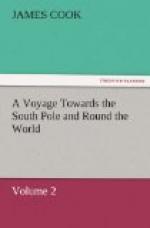If I except New Zealand, I, at this time, knew of no island in the South Pacific Ocean, where a ship could supply herself with a mast or yard, were she ever so much distressed for want of one. Thus far the discovery is or may be valuable. My carpenter, who was a mast-maker as well as a shipwright, two trades he learnt in Deptford-yard, was of opinion that these trees would make exceedingly good masts. The wood is white, close-grained, tough, and light. Turpentine had exuded out of most of the trees, and the sun had inspissated it into a rosin, which was found sticking to the trunks, and lying about the roots. These trees shoot out their branches like all other pines; with this difference, that the branches of these are much smaller and shorter; so that the knots become nothing when the tree is wrought for use. I took notice, that the largest of them had the smallest and shortest branches, and were crowned, as it were, at the top, by a spreading branch like a bush. This was what led some on board into the extravagant notion of their being basaltes: Indeed no one could think of finding such trees here. The seeds are produced in cones; but we could find none that had any in them, or that were in a proper state for vegetation or botanical examination. Besides these, there was another tree or shrub of the spruce-fir kind, but it was very small. We also found on the isle a sort of scurvy-grass, and a plant, called by us Lamb’s Quarters, which, when boiled, eat like spinnage.
Having got ten or twelve small spars to make studding-sail booms, boat-masts, etc., and night approaching, we returned with them on board.
The purpose for which I anchored under this isle being answered, I was now to consider what was next to be done. We had from the top-mast-head taken a view of the sea around us, and observed the whole, to the west, to be strewed with small islets, sand-banks, and breakers, to the utmost extent of our horizon. They seemed indeed not to be all connected, and to be divided by winding channels. But when I considered that the extent of this S.W. coast was already pretty




